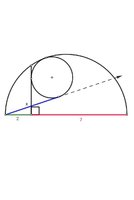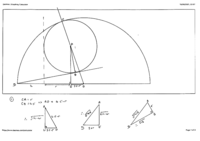You are using an out of date browser. It may not display this or other websites correctly.
You should upgrade or use an alternative browser.
You should upgrade or use an alternative browser.
GEOMETRY PROBLEM OF OLYMPIAD LEVEL
- Thread starter AdkAdi
- Start date
N
No please.Guide me throughInteresting problem. But did you read the posting guidelines?
No there is nothing much given..Were you able to find the range.if yes, then the can you provide the solutionIs there no more information?
I would have thought it is the 'range of possible values' for x, rather than 'the value' of x.
It seems to me you can put a circle of 'any size' in there - tangential to the vertical line and the semi-circle (limited by the size of the semi-circle) - just attach the circle to the vertical line and slide it up until it is just tangential to the semi-circle. x will vary accordingly, from 0, to the height of the vertical line. The height of the vertical line can easily be calculated using Pythagoras' theorem - joining the centre of the semi-circle to the top of the vertical line (and you know the radius of the semi-circle).
It does seem suspiciously easy. That, and the language of the question ('value of x'), led me to question was there any more information given. Perhaps it is worth posting an image of the full question.
It does seem suspiciously easy. That, and the language of the question ('value of x'), led me to question was there any more information given. Perhaps it is worth posting an image of the full question.
lev888
Elite Member
- Joined
- Jan 16, 2018
- Messages
- 2,940
Based on the colors of other segments, I would say x is the length of the entire blue segment.For some reason, I have taken x to be the height. Perhaps it is meant to be the first part of the blue diagonal line. In that case it would range from 2, to the distance to the top of the vertical line (easily calculated using Pythagoras’ thm).
D
Deleted member 4993
Guest
I agree!Based on the colors of other segments, I would say x is the length of the entire blue segment.
This is the full question.I know it's confusing, but I have posted the complete question which is Nothin but the diagram.It seems to me you can put a circle of 'any size' in there - tangential to the vertical line and the semi-circle (limited by the size of the semi-circle) - just attach the circle to the vertical line and slide it up until it is just tangential to the semi-circle. x will vary accordingly, from 0, to the height of the vertical line. The height of the vertical line can easily be calculated using Pythagoras' theorem - joining the centre of the semi-circle to the top of the vertical line (and you know the radius of the semi-circle).
It does seem suspiciously easy. That, and the language of the question ('value of x'), led me to question was there any more information given. Perhaps it is worth posting an image of the full question.
I calculated the length of the blue line for the smallest possible 'inner small circle' (0 radius!) and for the largest 'inner small circle' which just touches the diameter line, and got the same answer for both [MATH]3\sqrt{2}[/MATH]. Perhaps there is a single value after all?
Than
Thank you so much.I was stuck on this problem for more than three days. I am extremely grateful to you.Yes. I've taken a look at it again and [MATH]x[/MATH] is constant = [MATH]3\sqrt{2}.[/MATH]View attachment 27838
Oh dear. That is perseverance! It was a difficult problem - good experience.Thank you so much.I was stuck on this problem for more than three days. I am extremely grateful to you.
You're welcome.


